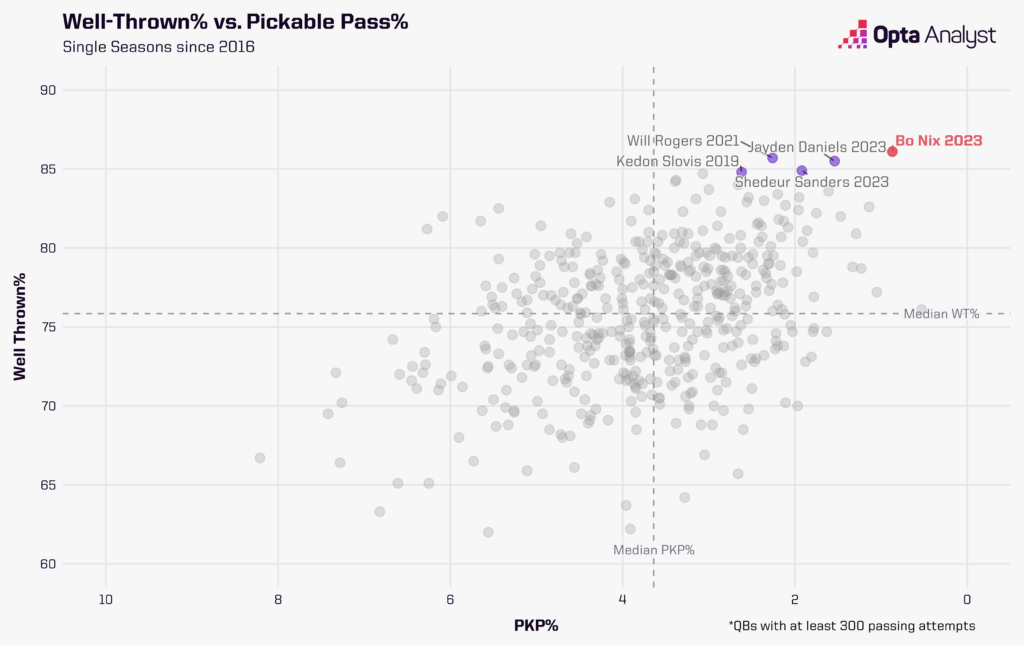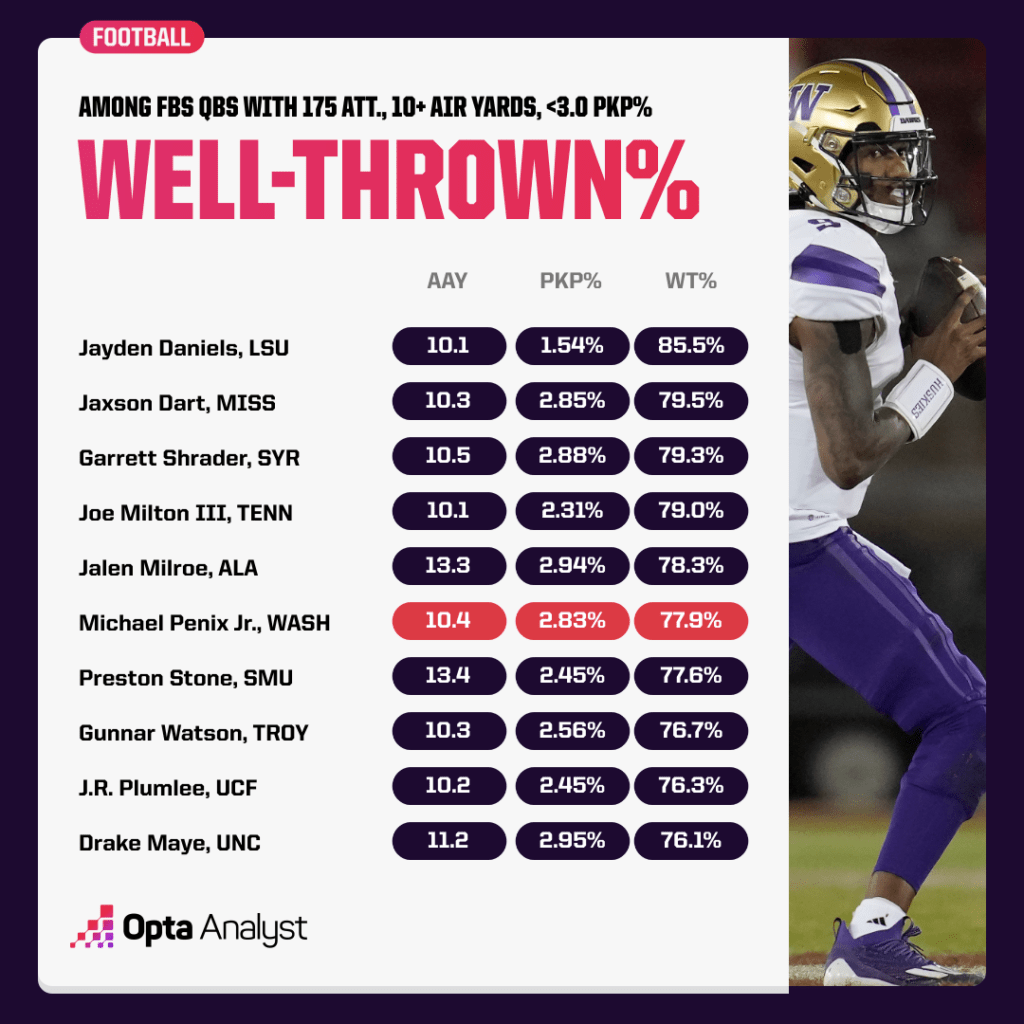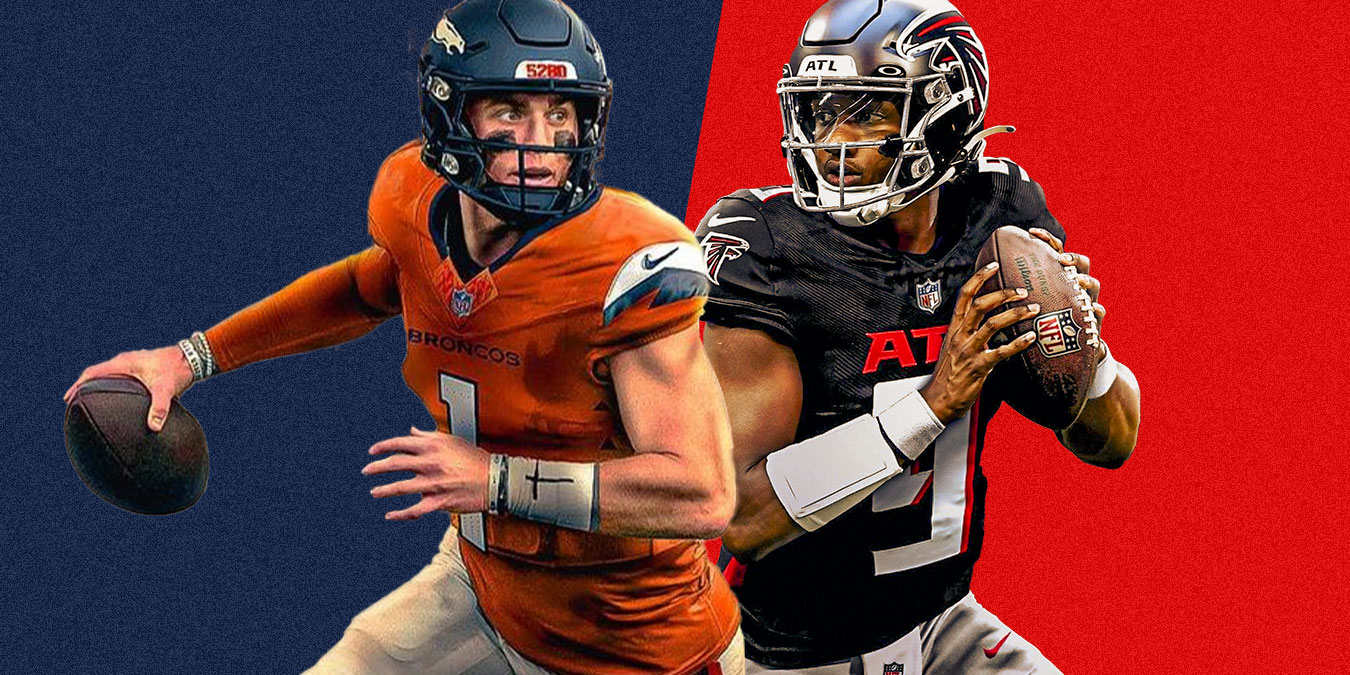The 2024 NFL Draft’s most shocking picks, Michael Penix Jr. and Bo Nix, certainly opened some eyes. Which of these off-the-radar picks has the better chance of panning out? The data helps point us in a direction.
Every NFL Draft has surprises.
2024’s, though, had two outright stunners in the first 12 picks.
The Atlanta Falcons were weeks removed from guaranteeing $100 million to Kirk Cousins when they spent the No. 8 pick on Washington quarterback Michael Penix Jr., whom most analysts didn’t think would get picked until the late first or second round.
Cousins’ agent quickly told reporters that the club hadn’t informed its prized signee of the plan to draft another quarterback. And general manager Terry Fontenot somehow made things weirder when he said that it would be a “great problem” if Penix, already old for a draft pick at 24, sat for four or five years before getting his turn as Atlanta’s starter.
The pick has been widely panned as a representation of bad asset management.
The Denver Broncos performed their own oddity with the No. 12 pick, when they grabbed Oregon quarterback Bo Nix. Like Penix, Nix is already 24, and like Penix, the media consensus was that he would not come off the board until much later in the draft.
Nix was mediocre for three years at Auburn before a transfer into Oregon’s smartly designed offense unlocked something new in him. Still, nearly no one figured he’d go this quickly. And the short-term value he could provide as a QB on a depressed rookie contract is mitigated by the enormous outlays the Broncos will be making to Russell Wilson, who will get nearly $40 million from the Broncos this year while he plays for the Pittsburgh Steelers.
Which of these off-the-radar picks has the better chance of panning out? Or, at the least, of not going down as a cataclysmic mistake on the part of the team that made it?
The Case for Nix
Nix was an excellent college QB by the end of his career, as his status as a Heisman Trophy finalist in 2023 attested. In his fifth season, he set the single-season NCAA record for completion percentage (77.45). And as game-charting data shows, Nix really was just as on-target as that sparking number suggests.
He led all FBS passers (minimum 100 attempts) with an 86.2% well-thrown rate, and his 0.87 pickable pass percentage was second. They were also two of college football’s best single-season marks since 2016.

That excellence came in structure. Nix averaged 6.7 air yards, 159th out of 164 quarterbacks. He did not freelance beyond what the Ducks asked of him; his 80.5% “in-design” rate (ID%) was well above the 77.0% national average. (ID% measures how many of a quarterback’s plays unfold within the envisioned play call – as opposed, for instance, to scrambles and throws flushed from the pocket.) Nix buried opponents with a barrage of short passes and put up a 45-touchdown, three-interception season.
If the Broncos can design a scheme for Nix that lets him quickly distribute the ball to playmakers at short depth, things could go great for everyone. It will be hard to replicate anything like the Oregon system in the NFL, though.
Last season, eight NFL quarterbacks averaged 7.0 air yards or fewer. They were Mac Jones, Patrick Mahomes, Jake Browning, Tommy DeVito, Dorian Thompson-Robinson, Tyson Bagent and Trevor Siemian.
That might tell us two things: One, you can build a great QB career around short passes to receivers who are smartly spaced around the field. Joe Burrow and Mahomes have done it. Two, it’s pretty hard. Most quarterbacks who throw the ball to such a short depth aren’t Burrow or Mahomes. Anything other than that offensive design will mean asking Nix to do something he didn’t do regularly at Oregon.
Nix also performed quite well on deeper throws with the Ducks, but they were few and far between. Hopefully, Sean Payton has a better plan than he had last year with Wilson.
The Case for Penix
Penix didn’t have the same precision numbers as Nix, but there’s a simple reason why: He was making substantially longer, more ambitious throws. Penix’s 77.9% well-thrown ball rate was above the national average, as was his 2.83% pickable pass rate.
But where he really stuck out was that he averaged 10.4 air yards, a top-40 rate nationally and more than any elite QBs except Alabama’s Jalen Milroe (whose best skill was his running) and UNC’s Drake Maye, now a New England Patriot. Penix sometimes fields skepticism because he benefited from an elite Washington wide receiver room (including top-10 pick Rome Odunze), but he aired the ball out to get it to those stars.

Penix’s release time was about 2.7 seconds, longer than average, as he let routes develop and then uncorked. He also achieved a lot of his success while improvising, with an “in-design” rate of 72.5%, well below the national average.
While Nix was prescribed a plan and executed it by making high-quality, simple throws, Penix often freelanced and had his success while pushing the ball down the field.
Penix’s mix of downfield aggressiveness and accuracy is unusual among college quarterbacks, even the best ones. In 2023, Penix was 29th in the country in catchable ball rate at 76.6%. But the QBs ahead of him averaged just 8.2 air yards, more than two less than Penix’s 10.4. Only LSU’s Jayden Daniels (at 10.1) was even in Penix’s air-yardage neighborhood.
Daniels went No. 2 to the Washington Commanders. No. 1 pick Caleb Williams averaged 9.1 air yards and had an 80.1% catchable ball rate.
Even among elite prospects, Penix stands out for distance and catchability.
Who Has the Better Shot?
Your answer probably depends on what you value most. Nix is more mobile than Penix, having scrambled much more frequently (20 times to seven) and successfully (6.6 yards to 2.9). Nix also has a more established track record of doing exactly what he’s told in an offensive system.
That could be a good thing if the Broncos design the ideal structure for him, or a bad one if he’s too limited to run a standard NFL offense with more downfield passing than he was asked to do for Oregon.
Meanwhile, Penix has a significant injury history that many thought would knock him lower on draft night, but he also has a bigger frame than Nix and a chance to develop for at least a year (or two or three or four) behind Cousins. Then again, a long time in the QB incubator doesn’t necessarily offer an advantage. For every Jordan Love who thrives after a long time on the bench, there are 20 drafted backups who never cut it as starters.
But let’s not be boring. Who does the data see as the better bet for long-term success?
It’s Penix. That’s primarily because of that unusual blend of downfield passing and accuracy.
Zach Wilson and Sam Howell had similar profiles coming out of college: high average air yards per attempt, a good pickable pass percentage, a high release time and a good well-thrown percentage. That might not inspire much confidence, but the Falcons likely have a better group of pass catchers and open-field runners than those Jets and Commanders teams.
Atlanta will be led by recent first-round picks like receiver Drake London, tight end Kyle Pitts and tailback Bijan Robinson, and Penix’s strength at Washington was that he gave a talented group of wideouts the optimal chance to make plays on well-placed balls thrown a long way.
To further the point, the players who most closely fit his profile in the NFL last season were Jalen Hurts, Josh Allen and Lamar Jackson – all three were in the playoffs in 2023 and have been MVP candidates in recent seasons.
Of course, whether any of Atlanta’s playmakers will still be there by the time Penix becomes the starting QB is an open question. But at least we can squint and see it. When the team at issue is the Atlanta Falcons, that’s all anyone can ask.
Check out our MLB, NBA and NFL coverage. Follow us on X and Instagram for more!

